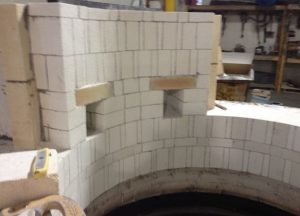
Commercial boilers are constantly subjected to high heat, pressure, and chemicals. This combination of stresses can quickly result in damage or even failure of the boiler. The refractory helps to protect and strengthen commercial boilers and high-temperature furnaces. Here is an overview of refractory material that is used in these boilers and furnaces.
A Closer Look at Refractory Materials
The refractory in a boiler or furnace is a special lining that protects the equipment. The refractory material must be resistant to high temperatures, pressure, chemicals, and physical wear. It must also be carefully matched to the environment. Refractory material may be used to line portions of a boiler or furnace, to fill in any voids or gaps, or to protect wall tubes. In boilers or furnaces where the refractory has been properly installed and maintained, the refractory protects the internal components and helps to conserve energy.
 The most common type of refractory is boiler-shaped or brick-shaped. These refractories look like bricks when they are installed. However, some refractories are made from other materials like ramming mixes, gunning mixes, castables, or plastics. Most refractory materials are non-metallic, and may be made from either synthetic or natural components. Some of the minerals or compounds that may be used to produce refractory material include dolomite, magnesite, alumina, chromite, silicon carbide, zirconia, and bauxite.
The most common type of refractory is boiler-shaped or brick-shaped. These refractories look like bricks when they are installed. However, some refractories are made from other materials like ramming mixes, gunning mixes, castables, or plastics. Most refractory materials are non-metallic, and may be made from either synthetic or natural components. Some of the minerals or compounds that may be used to produce refractory material include dolomite, magnesite, alumina, chromite, silicon carbide, zirconia, and bauxite.
Refractory failure is one of the most common reasons for boiler shut downs or inefficiency. Installing the correct refractory and maintaining it properly will save money in the long-term because of increased efficiency and reduced downtime.
R.G. Smith Company provides refractory repairs and new refractory construction services to businesses in all industries across Ohio and the Midwest. Our skilled team has the equipment and expertise to take care of your refractory needs. Contact us today to learn how we can help, whether you need repairs, a complete rebuild, or a new refractory.

Leave a Reply